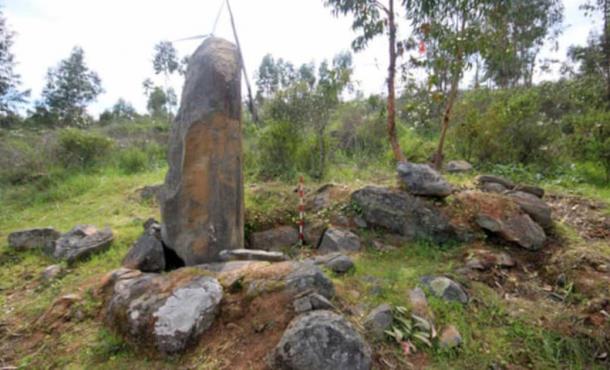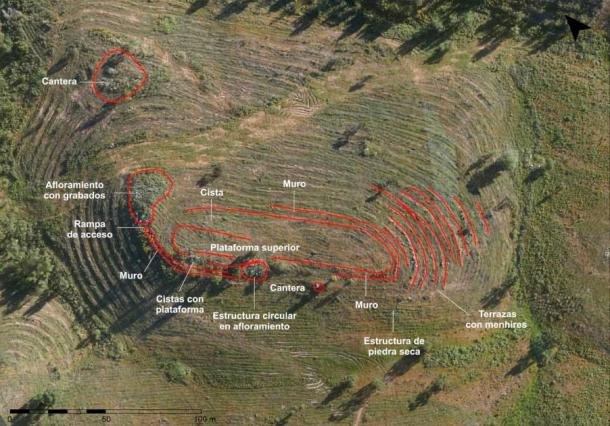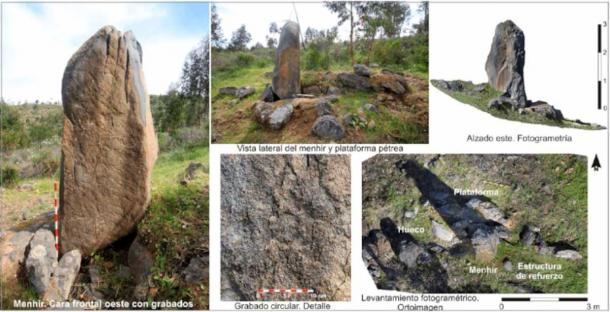
Unbelievable Find of Europe’s Largest Megalithic Site In Spain
How has this not been found before? A site planned for avocado production in southern Spain has revealed what archaeologists believe to be one of the largest megalithic sites in Europe! Dated to up to 7,000 years ago, the site contains more than 500 standing stones, and two stone circles similar to the Stonehenge in Britain’s Salisbury Plain. And there’s much more.
La Torre-La Janera and A Diverse Collection of Megaliths
Located near the border with Portugal in Huelva, La Torre-La Janera farm was planned to be converted to an avocado plantation by its owners. Spanning 600 hectares (or 1500 acres), the authorities of Junta de Andalucía requested a land survey citing potential archaeological significance, and they were not disappointed, reports El Pais.
The farm is on the left bank of the Guadiana River, around the Monte Gordo hill. On both sides of the border, previous archaeological finds include megaliths carved from greywacke, mica, feldspar, and quartz. This is in addition to two menhirs, five dolmens, three circular burial areas called tholoi, a large quarry, and four necropolises, and other scatted artifacts. And the source of the stones was a stones’ throw away (metaphorically) – 46 mines with abandoned quartzite hammers and half-finished blocks were found in the vicinity.

Side view of a menhir and stone platform at La Torre-La Janera megalithic site near Huelva. (University of Huelva)
Primitiva Bueno-Ramirez, Professor of Prehistory at the University of Alcalá de Henares, said of the site:
“So far, no such compact concentration of megalithic sites is known, anywhere in Europe, with such hopes of obtaining archaeological data, and I know all of them.”
She adds that finding everything ‘together’ at one site is a matter of huge rarity, hailing the site’s “excellent conservation”.
- 5 Lone Standing Stones of Europe – Our Old Menhir Warriors
- The Restless Peninsula: The Proud and Colorful History of Iberia

Aerial view of one of the megalithic complexes located on the La Torre-La Janera estate. (Andalusian Government)
The site yielded various kinds of megaliths, standing stones or menhirs, dolmens, mounds, coffin-like stone boxes (called cists), and enclosures. The height of the standing stones varied between 1 and 3.5 meters (3.2 and 11.48 feet), reports the Guardian. At their disposal lay satellite and aerial images and LiDAR, which helped reveal a diverse haul.
“This is the biggest and most diverse collection of standing stones grouped together in the Iberian Peninsula. It is a major megalithic site in Europe,” said José Antonio Linares, a researcher at Huelva University and one of the project’s three directors. The research conducted by him and his team have been published in Spanish archaeology journal, Trabajos de Prehistoria. It was the culmination of an 18-month study that had begun in 2021, but will be continuing till 2027, titled ‘ Menhigua: Menhirs and Megaliths at Bajo Guadiana’.
- Legends say Mysterious Women Built the Megaliths of Portugal
- The Mystery of the Ancient Greek ‘Dragon Houses’

The site huge site is packed with menhirs and platforms such as these. (UHU)
Ascertaining the Use and Purpose of the Site
“It is a unique site so far in the Iberian Peninsula . . . Communal activities around the menhirs and dolmens could have served to fix the territory of the ancestors, foster intergroup bonds of cohesion and create a memory of the place for a long period of time,” write the authors of the study.
The dolmens, burial mounds, and cists could have served as homes for the dead and substituted as ritual sites, with relics and offerings to ancestors. The communities could have used this site as a social platform to connect and heal with their ancestors. The archaeologists noted that ‘imperfect’ menhirs with cracks or breakages were discarded in favor of complete ones, indicating that they were required for something special.
They also speculate that there is some kind of connection with the cycle of the seasons, and the observation of celestial phenomena, though like the Stonehenge, it is going to be difficult to prove. The two stone circles, or cromlechs, were on the periphery of the hill, clearly facing the east. The authors write that these were “built on top of hills with a clear horizon to the east, from which the equinox and solstice sunrises can be seen.” Most of the menhirs were also grouped into 26 alignments. This leads to the conclusion that such positioning was designed to mimic an astronomical clock or calendar. Their U-shaped formation has been found at other circular sites in Portugal.
In a broader sense, what can be gauged for certain is the Atlantic megalithism is one of the oldest human phenomena. It carried a larger social purpose, transforming regions and humanizing them. It has also expanded the research capacity to understand the peninsular southwest as an area of megalithism in Western Europe, a lens it had not been looked at through before.
Many of the stones remain buried, and the excavation project is planned to continue into 2026, with a part of the site that can be visited.
Top image: Some of the hundreds of stones now mapped at the megalithic site in Huelva, Spain. Source: GONZÁLEZ BATANERO , D et al./ Antiquitas
By Sahir Pandey
References
AFP. 2022. Huge megalithic complex of more than 500 standing stones discovered in Spain. Available at: https://www.theguardian.com/science/2022/aug/18/megalithic-complex-standing-stones-discovered-spain.
Devereux, C. 2022. Spanish Stonehenge uncovered on avocado plantation. Available at: https://www.thetimes.co.uk/article/spanish-stonehenge-uncovered-on-farmland-3r99wbkxf.
Olaya, V.G. 2022. Discovered in Huelva one of the largest megalithic concentrations in Europe. Available at: https://elpais.com/cultura/2022-08-17/descubierta-en-huelva-una-de-las-mayores-concentraciones-megaliticas-de-europa.html.
UHU News. 2022. La revista "Trabajos de Prehistoria" del CSIC publica una investigación liderada por la UHU sobre el sitio megalítico La Torre-La Janera. Available at: http://www.uhu.es/noticias/la-revista-trabajos-de-prehistoria-del-csic-publica-una-investigacion-liderada-por-la-uhu
GONZÁLEZ BATANERO , D et al. 2022 Megalitismo no funerario en el Suroeste de la Península Ibérica: los nuevos enclaves de “La Torre” y “La Janera” (Ayamonte-Villablanca, Huelva). Available at: http://www.antiqvitas.es/revista/2021/antiquitas-33-2021-2-megalitismo.pdf
















Comments
I agree with Wagner about half the time. But these stones are for corded and beamed roof support. What they did under the roof is the mystery. Women make men build shelters.
From the article, “The dolmens, burial mounds, and cists could have served as homes for the dead and substituted as ritual sites, with relics and offerings to ancestors.”
More likely homes for the living, who suddenly died down there. No culture would have evolved that treated its dead better than its living.
Nobody gets paid to tell the truth.